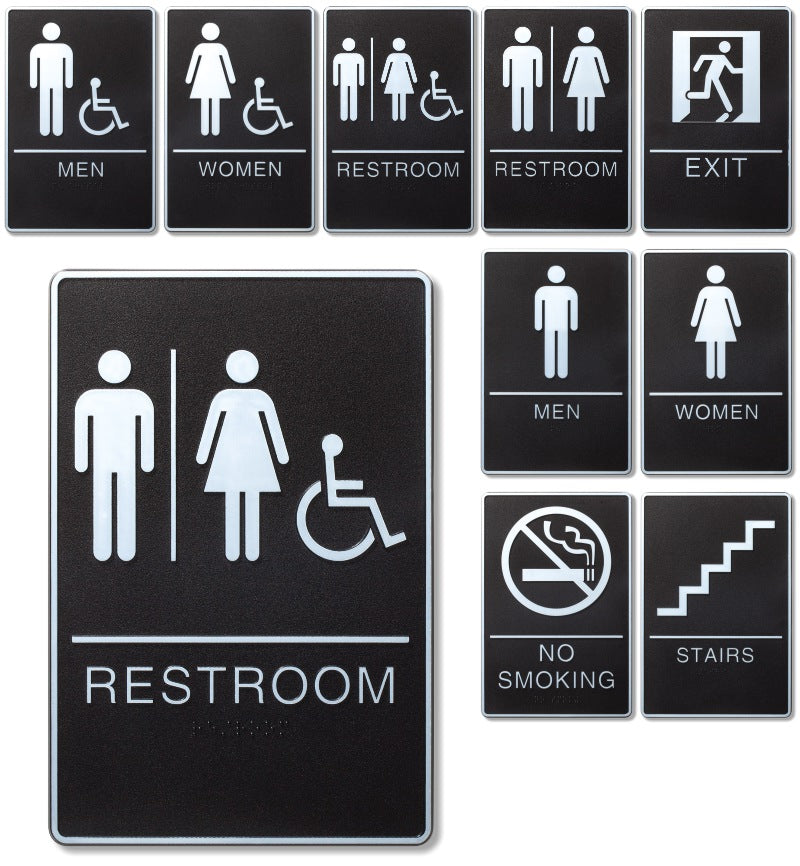Tailoring ADA Signs to Meet Your Particular Demands
Tailoring ADA Signs to Meet Your Particular Demands
Blog Article
Exploring the Key Attributes of ADA Indications for Enhanced Ease Of Access
In the realm of access, ADA signs offer as quiet yet powerful allies, making sure that spaces are navigable and comprehensive for people with impairments. By incorporating Braille and responsive aspects, these indicators break barriers for the aesthetically damaged, while high-contrast color plans and understandable fonts provide to varied visual needs.
Value of ADA Compliance
Making sure conformity with the Americans with Disabilities Act (ADA) is crucial for promoting inclusivity and equivalent gain access to in public rooms and workplaces. The ADA, passed in 1990, mandates that all public centers, employers, and transport services suit people with impairments, ensuring they delight in the very same civil liberties and chances as others. Compliance with ADA requirements not just meets lawful commitments but also enhances an organization's credibility by demonstrating its dedication to diversity and inclusivity.
One of the crucial elements of ADA compliance is the application of obtainable signage. ADA indications are created to guarantee that people with handicaps can conveniently browse via structures and areas. These indications should adhere to particular guidelines regarding dimension, typeface, shade comparison, and positioning to assure exposure and readability for all. Appropriately applied ADA signs assists remove obstacles that people with impairments frequently experience, thereby advertising their freedom and confidence (ADA Signs).
Moreover, sticking to ADA policies can minimize the danger of prospective fines and lawful consequences. Organizations that fail to adhere to ADA standards may encounter claims or charges, which can be both damaging and monetarily difficult to their public photo. Therefore, ADA conformity is important to promoting an equitable environment for every person.
Braille and Tactile Aspects
The incorporation of Braille and tactile components right into ADA signs embodies the concepts of accessibility and inclusivity. These functions are essential for people that are blind or visually impaired, enabling them to navigate public areas with better independence and confidence. Braille, a responsive writing system, is important in supplying created details in a layout that can be quickly perceived via touch. It is usually positioned beneath the corresponding text on signage to make sure that people can access the information without visual support.
Tactile components prolong past Braille and include raised characters and symbols. These parts are made to be noticeable by touch, enabling individuals to identify room numbers, restrooms, exits, and various other critical areas. The ADA establishes details standards relating to the size, spacing, and placement of these responsive aspects to enhance readability and make sure consistency across various environments.

High-Contrast Color Design
High-contrast color pattern play a pivotal duty in enhancing the presence and readability of ADA signage for people with visual problems. These plans are important as they take full advantage of the difference in light reflectance in between text and background, guaranteeing that indicators are easily noticeable, even from a range. The Americans with Disabilities Act (ADA) mandates using specific shade contrasts to accommodate those with minimal vision, making it a vital aspect of conformity.
The efficacy of high-contrast shades hinges on their capability to stick out in various lights conditions, consisting of dimly lit settings and locations with glow. Usually, dark message on a light background or light message on a dark history is employed to accomplish optimum contrast. For circumstances, black message on a yellow or white background offers a plain aesthetic distinction that aids in quick acknowledgment and understanding.

Legible Fonts and Text Size
When taking into consideration the design of ADA signs, the option of clear typefaces and ideal text size can not be overstated. The Americans with Disabilities Act (ADA) mandates that fonts have to be not italic and sans-serif, oblique, script, highly ornamental, or of unusual kind.
The size of the message also plays a crucial role in access. According to ADA guidelines, the minimum text height need to be 5/8 inch, and it must raise proportionally with seeing range. This is particularly important in public rooms where signage requirements to be read quickly and accurately. Consistency in message size adds to a cohesive aesthetic experience, assisting people in browsing environments successfully.
In addition, spacing between lines and letters is important to clarity. Adequate spacing stops characters from appearing crowded, boosting readability. By adhering to these requirements, developers can substantially boost ease of access, making certain that signage serves its desired purpose for all individuals, no matter of their aesthetic capabilities.
Reliable Placement Techniques
Strategic positioning of ADA signs is necessary for maximizing accessibility and ensuring conformity with lawful requirements. ADA guidelines specify that indicators must be installed at a height in between 48 to 60 inches from the ground to guarantee they are within the line of view for both standing and seated people.
In addition, indications must be positioned nearby to the lock side of doors to enable very easy identification before access. Consistency in indicator positioning throughout a facility boosts predictability, minimizing confusion and boosting general user experience.

Verdict
ADA signs play an important function in advertising availability by integrating features that address the demands of individuals with impairments. Including Braille and responsive components guarantees important details is available to the visually impaired, while high-contrast shade plans and readable sans-serif typefaces boost presence throughout various lighting conditions. Effective placement techniques, such as suitable installing heights and calculated places, additionally assist in navigating. These aspects jointly promote an inclusive atmosphere, highlighting the significance of ADA compliance in guaranteeing equal access for all.
In the world of access, ADA indicators serve as quiet yet effective allies, making sure that spaces are accessible and comprehensive for people with impairments. The ADA, enacted in 1990, mandates that all public centers, companies, and transport services suit people with impairments, guaranteeing they take pleasure in the same civil liberties and chances as others. ADA Signs. ADA signs are made to make sure that individuals with handicaps can quickly browse with structures and areas. you can check here ADA standards state that indicators must be mounted at a height in between 48 to 60 inches from the ground to guarantee they are within the line of view for both standing and seated people.ADA indicators play a crucial function in advertising ease of access by incorporating functions that resolve the requirements of people with impairments
Report this page